fuel type CHEVROLET SUBURBAN 1994 Owners Manual
[x] Cancel search | Manufacturer: CHEVROLET, Model Year: 1994, Model line: SUBURBAN, Model: CHEVROLET SUBURBAN 1994Pages: 385, PDF Size: 19.88 MB
Page 258 of 385
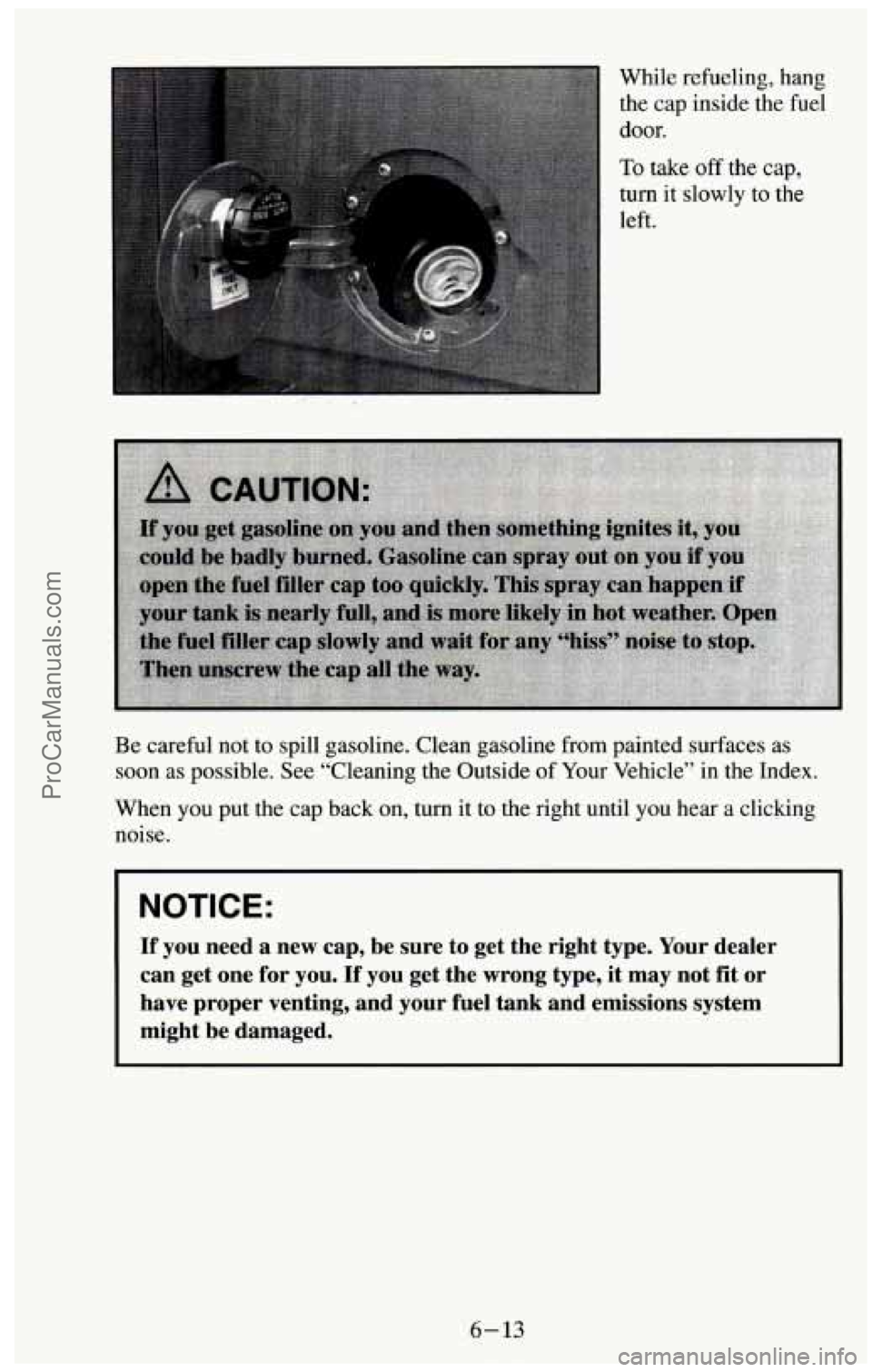
While refueling, hang
the cap inside the fuel
door.
To take off the cap,
turn it slowly to the
left.
,
Be careful not to spill gasoline. Clean gasoline from painted surfaces as
soon as possible. See “Cleaning the Outside of Your Vehicle” in the Index.
When you put the cap back on, turn it to the right until you hear
a clicking
noise.
I NOTICE:
If you need a new cap, be sure to get the right type. Your \
dealer
can get one for you.
If’ you get the wrong type, it may not fit or
have proper venting, and your fuel tank and emissions system
might be damaged.
6-13
ProCarManuals.com
Page 308 of 385
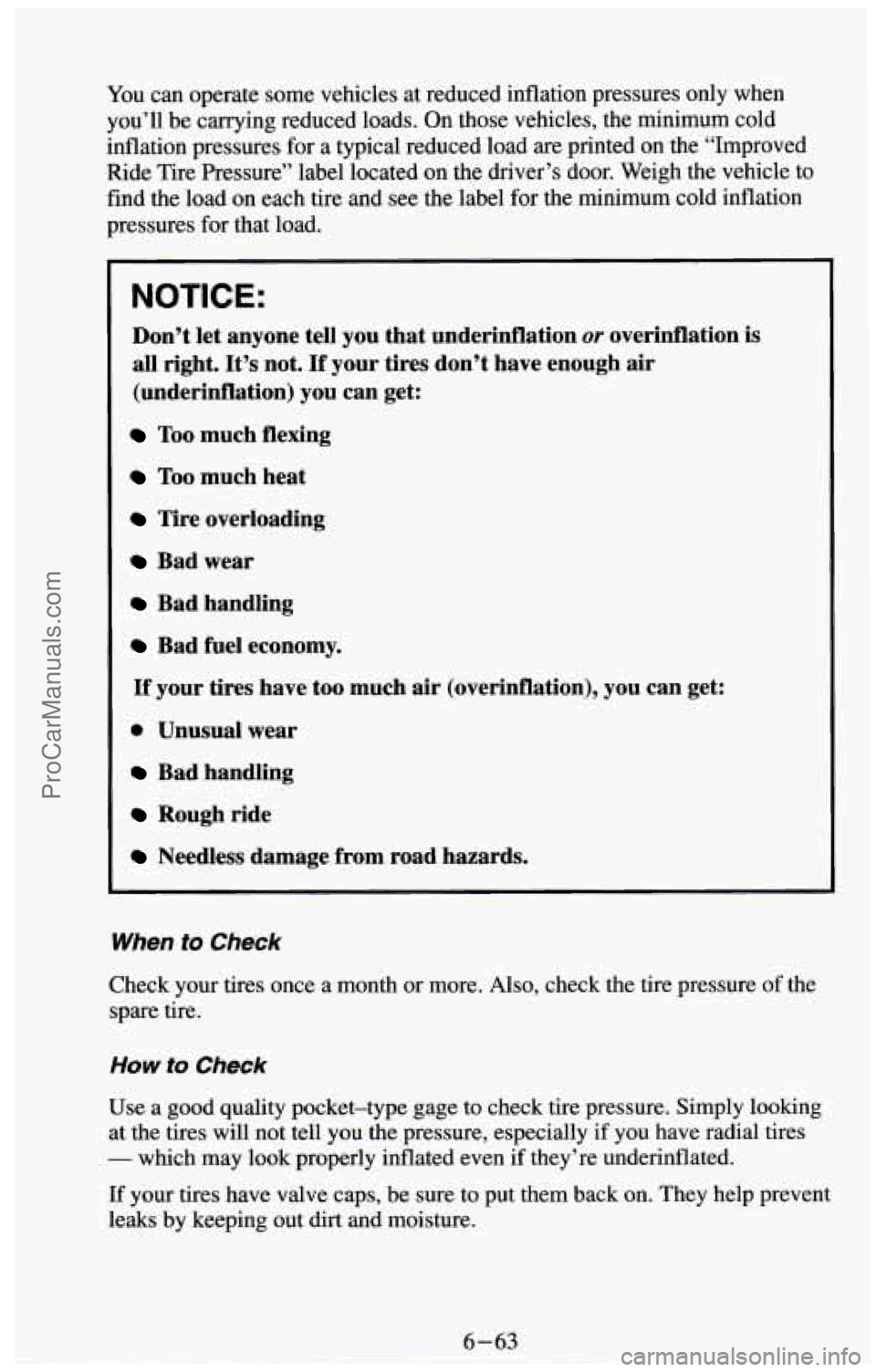
You can operate some vehicles at reduced inflation pressures only when
you’ll be carrying reduced loads. On those vehicles, the minimum cold
inflation pressures for a typical reduced load are printed on the “Improved
Ride Tire Pressure” label located on the driver’s door. Weigh the vehicle to
find the load on each tire and see the label for the minimum cold inflation
pressures for that load.
Don’t let anyone tell you that underinflation or overinflation is
all right.
It’s not. If your tires don’t have enough air
(underinflation) you can get:
Too much flexing
Too much heat
Tire overloading
Bad wear
Bad handling
Bad fuel economy.
If your tires have too much air (overinflation), you can get:
0 Unusual wear
Bad handling
Rough ride
Needless damage from road hazards.
When to Check
Check your tires once a month or more. Also, check the tire pressure of the
spare tire.
How to Check
Use a good quality pocket-type gage to check tire pressure. Simply looking
at the tires will not tell you the pressure, especially
if you have radial tires
- which may look properly inflated even if they’re underinflated.
If your tires have valve caps, be sure to put them back on. They help prevent
leaks by keeping out dirt and moisture.
ProCarManuals.com
Page 326 of 385
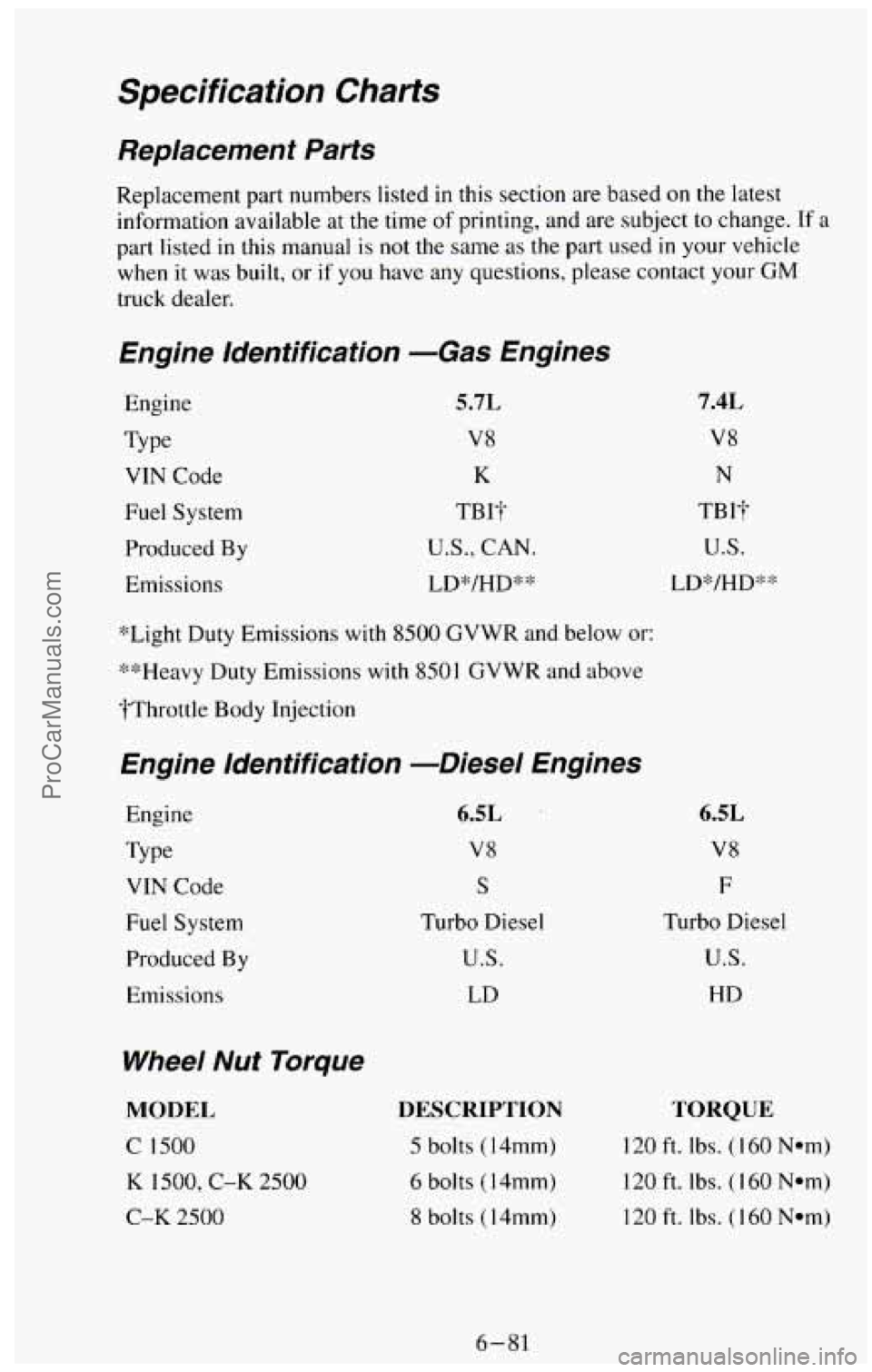
Specification Charts
Replacement Parts
Replacement part numbers listed in this section are based on the latest
information available
at the time of printing, and are subject to change. If a
part listed in this manual
is not the same as the part used in your vehicle
when
it was built, or if you have any questions, please contact your GM
truck dealer.
Engine Identification -Gas Engines
Engine
Type VIN Code
Fuel System
Produced By
Emissions
5.7L
V8
K
TBIT
U.S., CAN.
JJD*/HD**
“Light Duty Emissions with
8500 GVWR and below or:
**Heavy Duty Emissions with 8501 GVWR and above
?Throttle Body Injection
Engine Identification -Diesel Engines
Engine
Type VIN Code
Fuel System
Produced By
Emissions
Wheel Nut Torque
MODEL
C 1500
K 1500, C-K 2500
C-K 2500
6.5L
V8
S
Turbo Diesel
U.S.
LD
DESCRIPTION
5 bolts (14mm)
6 bolts (14mm)
8 bolts (14mm)
6.5L
V8
F
Turbo Diesel
U.S.
HD
TORQUE
120 ft. lbs. (1 60 Nom)
120 ft. lbs. ( 1 60 Nom)
I20 ft. Ibs. (I 60 Nom)
6-81
ProCarManuals.com
Page 327 of 385
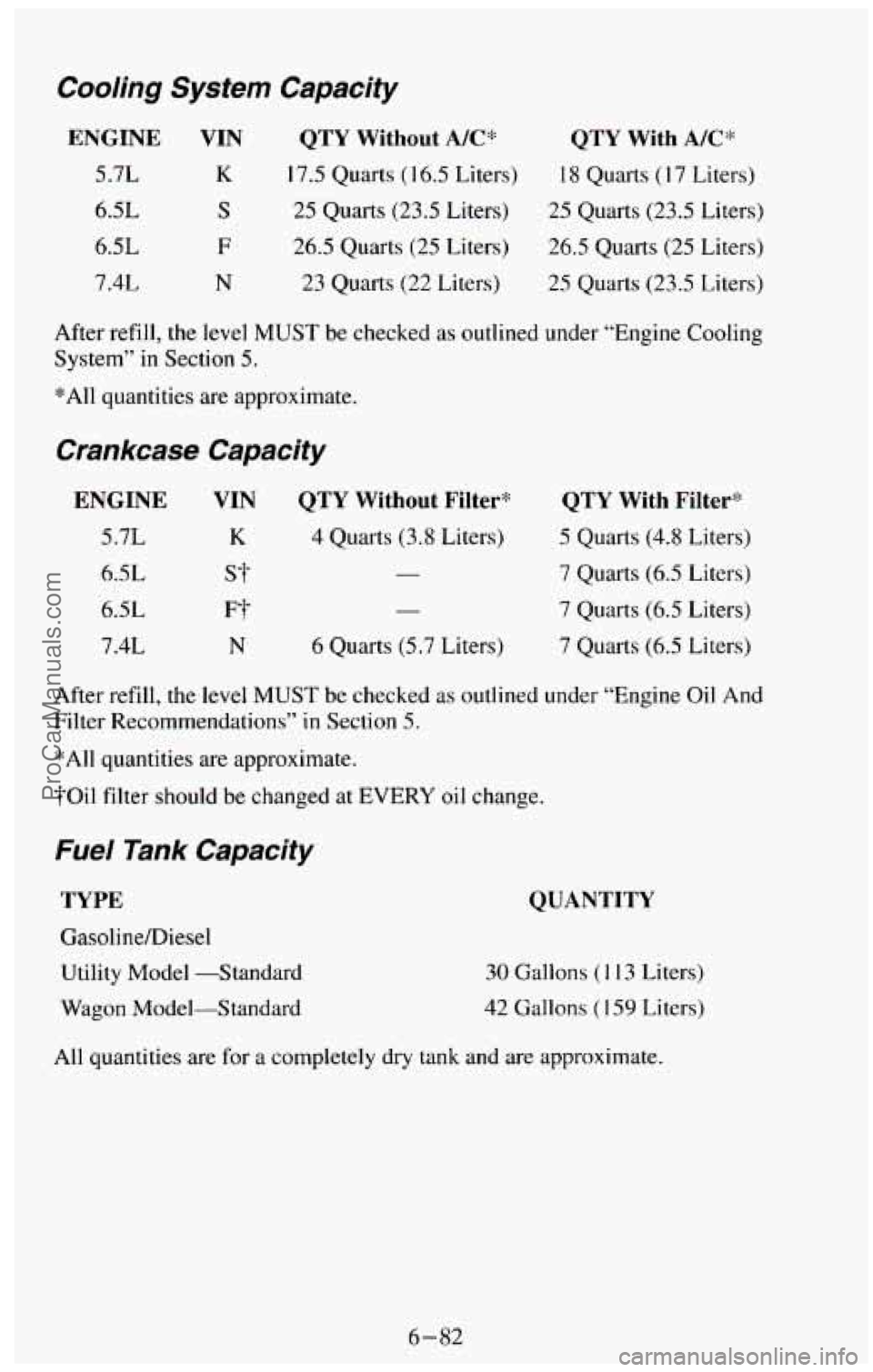
Cooling System Capacity
ENGINE VIN
5.7L K
6.5L S
6.5L F
7.4L N
QTY Without AfC* QTY With A/C*
17.5 Quarts (1 6.5 Liters)
18 Quarts ( I7 Liters)
25 Quarts
(23.5 Liters) 25 Quarts (23.5 Liters)
26.5 Quarts (25 Liters)
26.5 Quarts (25 Liters)
23 Quarts (22 Liters)
25 Quarts (23.5 Liters)
After refill, the level MUST be checked as outlined under “Engine Cooling
System”
in Section 5.
*All quantities are approximate.
Crankcase Capacity
ENGINE
5.7L
6.5L
6.5L
7.4L
VIN
K
ST
F?
N
QTY Without Filter“
4 Quarts (3.8 Liters)
6 Quarts (5.7 Liters)
QTY With Filter:$
5 Quarts (4.8 Liters)
7 Quarts (6.5 Liters)
7 Quarts
(6.5 Liters)
7 Quarts (6.5 Liters)
After refill, the level MUST be checked
as outlined under “Engine Oil And
Filter Recommendations”
in Section 5.
*All quantities are approximate.
?Oil filter should be changed at
EVERY oil change.
Fuel Tank Capacity
TYPE
Gasoline/Diesel
Utility Model -Standard
Wagon Model-S tandard
QUANTITY
30 Gallons (I 13 Liters)
42 Gallons (I 59 Liters)
All quantities are for a completely dry tank and are approximate.
6-82
ProCarManuals.com
Page 328 of 385
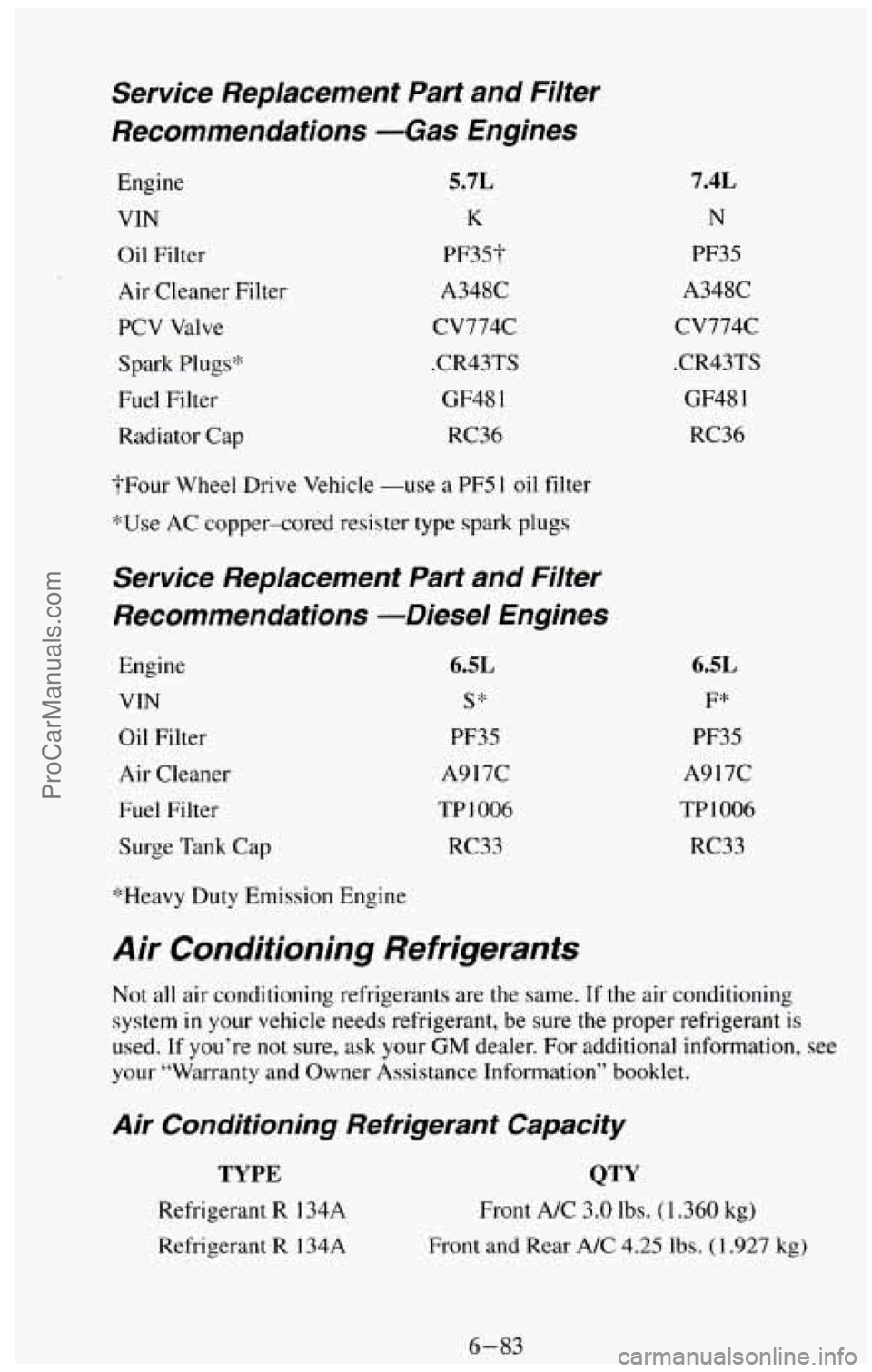
Service Replacement Part and Filter
Recommendations -Gas Engines
Engine
VIN
Oil Filter
Air Cleaner Filter
PCV Valve
Spark Plugs‘%
Fuel Filter
Radiator Cap
5.7L
K
PF353‘
A348C
cv774c
.CR43TS
GF48 1
RC36
$Four Wheel Drive Vehicle -use a
PFS 1 oil filter
*Use AC copper-cored resister type spark plugs
Service Replacement Part and Filter
Recommendations -Diesel Engines
Engine
VIN
Oil Filter
Air Cleaner
Fuel Filter
Surge Tank Cap 6.5L
S”
PF3S
A917C
TP
I 006
RC33
7.4L
N
PF35
A348C
cv774c
.CR43TS
GF48
I
RC36
6.5L
F”
PF35
A9 17C
TP
1006
RC33
*Heavy Duty Emission Engine
Air Conditioning Refrigerants
Not all air conditioning refrigerants are the same. If the air conditioning
system
in your vehicle needs refrigerant, be sure the proper refrigerant is
used. If you’re not sure, ask your GM dealer. For additional information, see
your “Warranty and Owner Assistance Information” booklet.
Air Conditioning Refrigerant Capacity
TYPE
Refrigerant R 134A
Refrigerant
R 134A
QTY
Front A/C 3.0 lbs. (1.360 kg)
Front and Rear A/C
4.25 Ibs. (I .927 kg)
6-83
ProCarManuals.com
Page 336 of 385
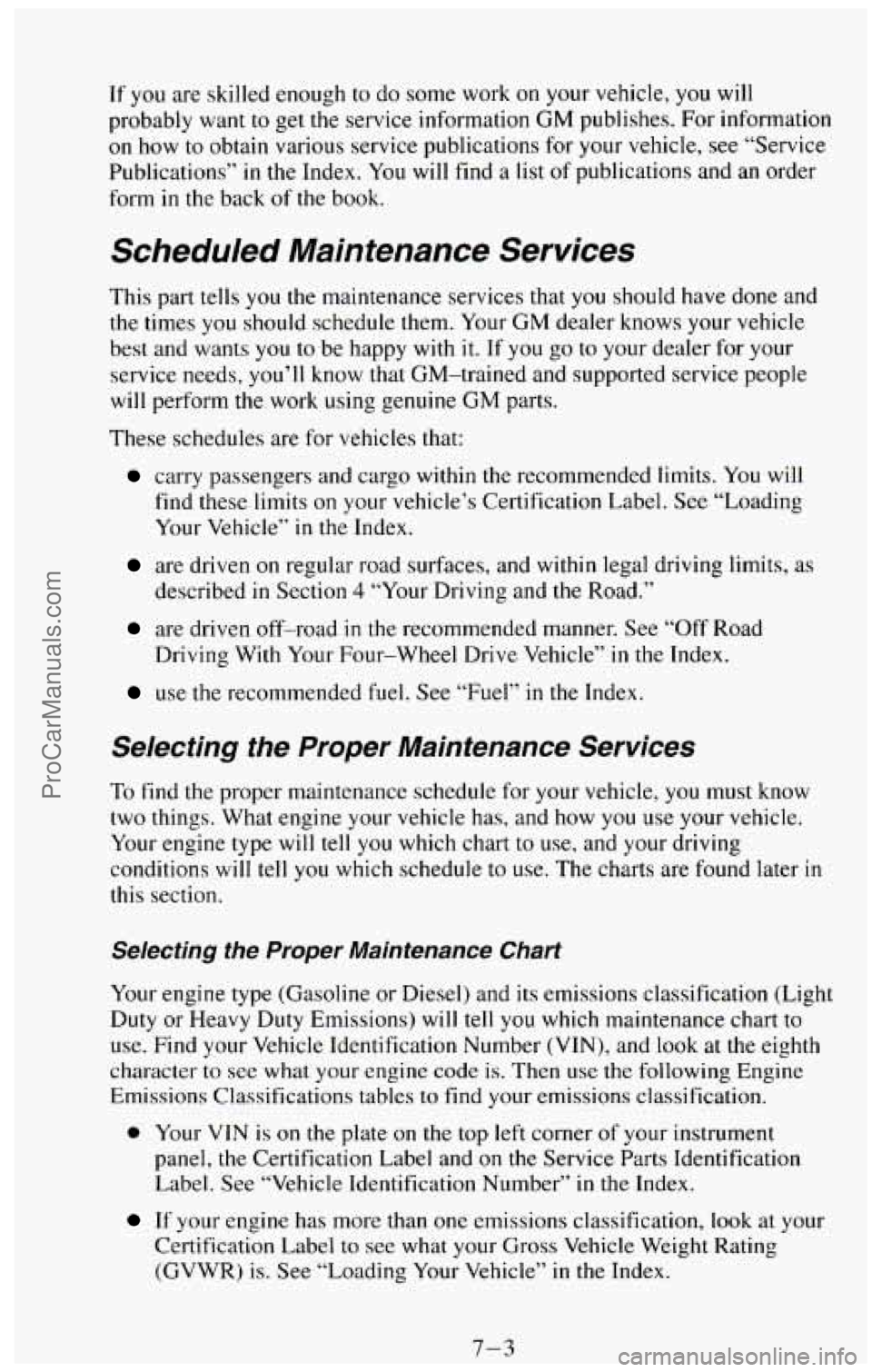
If you are skilled enough to do some work on your vehicle, you will
probably want
to get the service information GM publishes. For information
on how to obtain various service publications for your vehicle, see “Service
Publications”
in the Index. You will find a list of publications and an order
form
in the back of the book.
Scheduled Maintenance Services
This part tells you the maintenance services that you should have done and
the times you should schedule them. Your GM dealer knows your vehicle
best and wants
you to be happy with it. If you go to your dealer for your
service needs, you’ll know that GM-trained and supported service people
will perform the work using genuine GM parts.
These schedules are for vehicles that:
carry passengers and cargo within the recommended limits. You will
find these limits
on your vehicle’s Certification Label. See “Loading
Your Vehicle”
in the Index.
are driven on regular road surfaces, and within legal driving limits, as
described in Section 4 “Your Driving and the Road.”
are driven off-road in the recommended manner. See “Off Road
Driving With Your Four-wheel Drive Vehicle”
in the Index.
use the recommended fuel. See “Fuel” in the Index.
Selecting the Proper Maintenance Services
To find the proper maintenance schedule for your vehicle, you must know
two things. What engine your vehicle has, and
how you use your vehicle.
Your engine type will tell
you which chart to use, and your driving
conditions will tell
you which schedule to use. The charts are found later in
this section.
Selecting the Proper Maintenance Chart
Your engine type (Gasoline or Diesel) and its emissions classification (Light
Duty or Heavy Duty Emissions) will tell
you which maintenance chart to
use. Find your Vehicle Identification Number (VIN), and look at the eighth
character to see what your engine code
is. Then use the following Engine
Emissions Classifications tables
to find your emissions classification.
0 Your VIN is on the plate on the top left corner of your instrument
panel, the Certification Label and
on the Service Parts Identification
Label. See “Vehicle Identification Number” in the Index.
If your engine has more than one emissions classification, look at your
Certification Label to see what your Gross Vehicle Weight Rating
(GVWR)
is. See “Loading Your Vehicle” in the Index.
7-3 ProCarManuals.com
Page 337 of 385
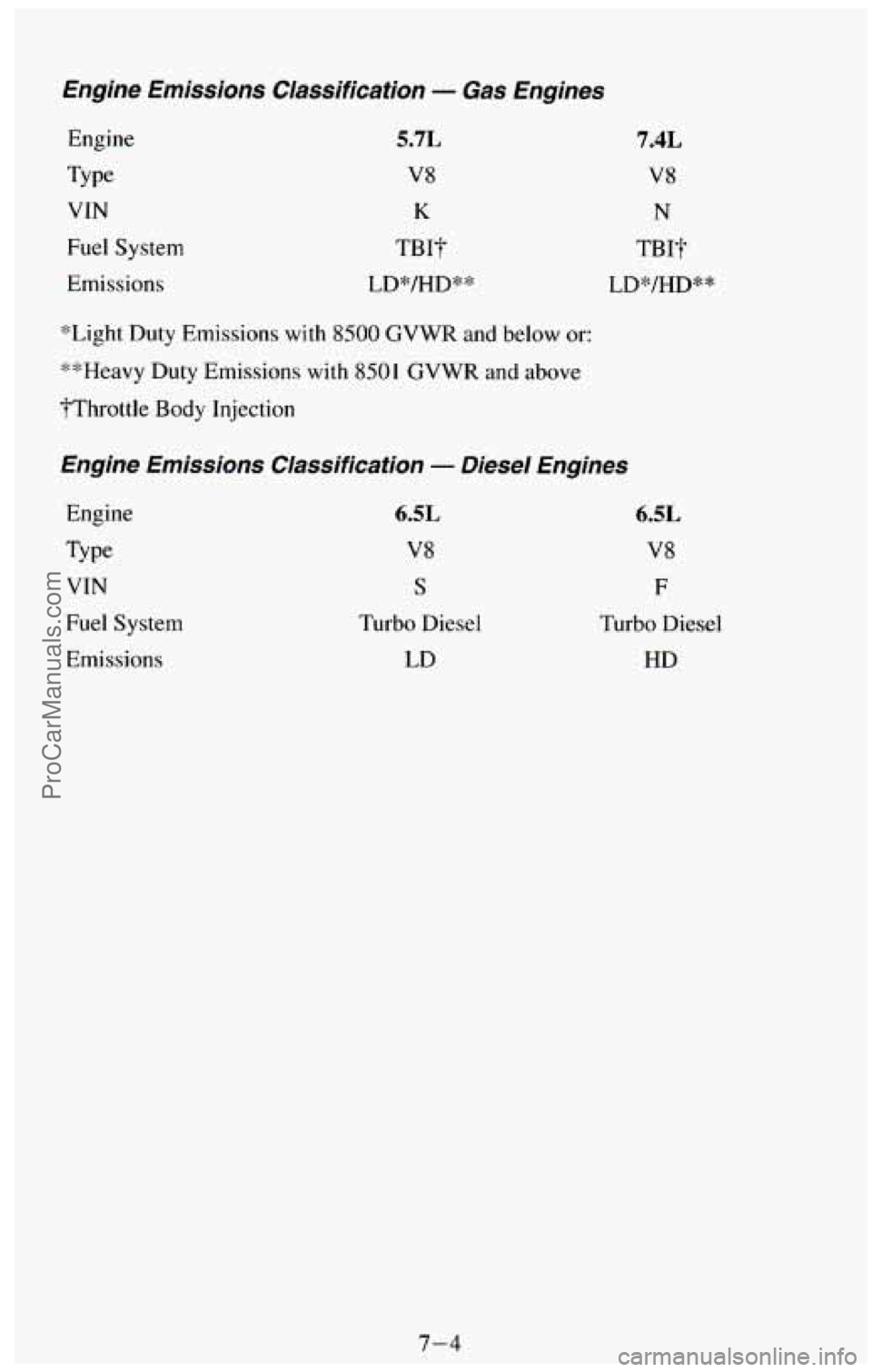
Engine Emissions Classification - Gas Engines
Engine
Type
VIN
Fuel System
Emissions
5.7L
V8
K
TBIT
LD*/HD**
7.44
V8
N
TBIT
LD*/HD**
*Light Duty Emissions with
8500 GVWR and below or:
**Heavy Duty Emissions with
8501 GVWR and above
?Throttle Body Injection
Engine Emissions Classification - Diese/ Engines
Engine
Type
VIN
Fuel System
Emissions
6.5L
V8
S
Turbo Diesel
LD
6.5L
V8
F
Turbo Diesel
HD
7-4
ProCarManuals.com
Page 352 of 385
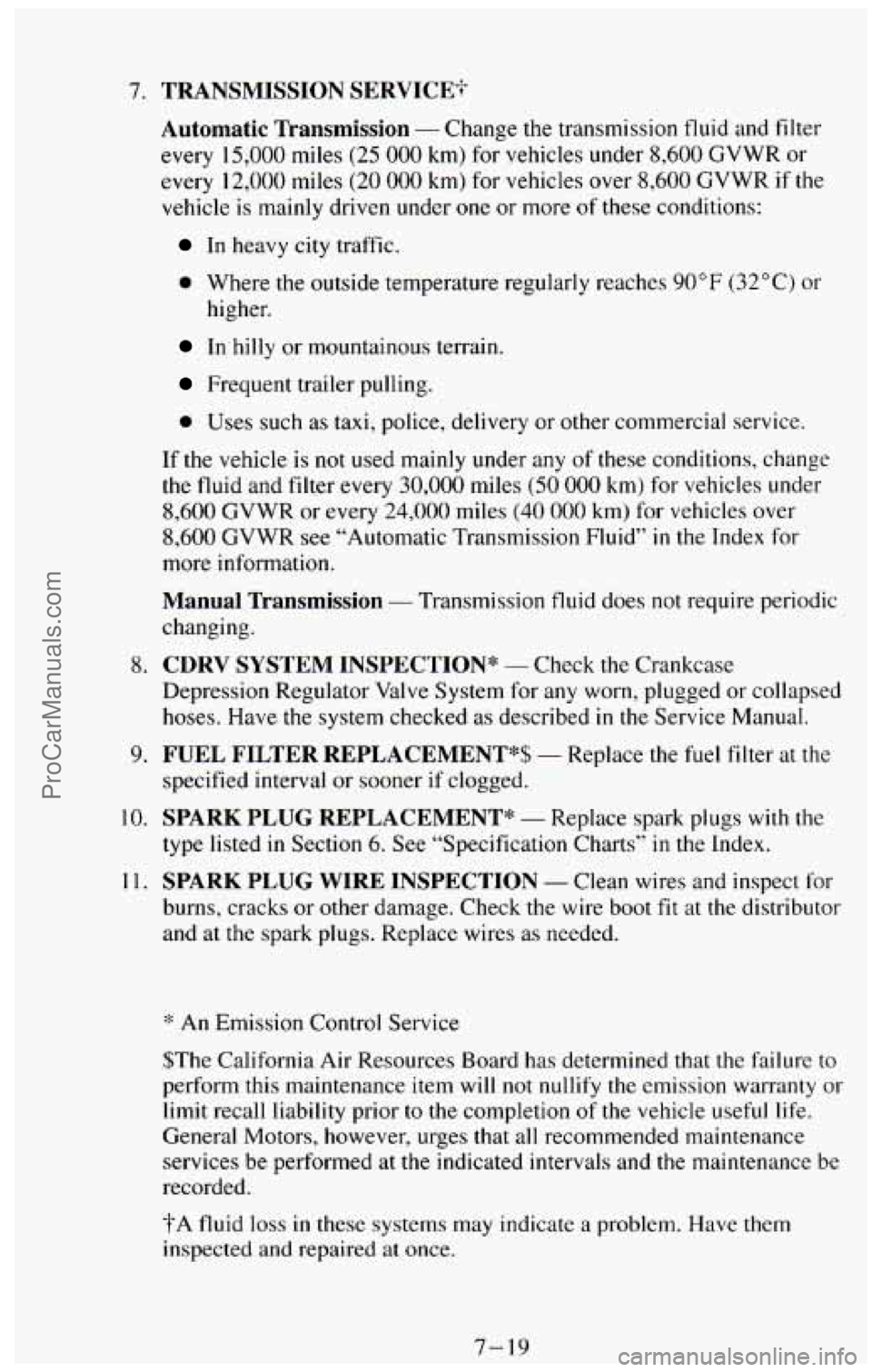
7. TRANSMISSION SERVICE;-
Automatic Transmission
- Change the transmission fluid and filter
every 15,000 miles
(25 000 km) for vehicles under 8,600 GVWR or
every 12,000 miles
(20 000 km) for vehicles over 8,600 GVWR if the
vehicle
is mainly driven under one or more of these conditions:
In heavy city traffic.
0 Where the outside temperature regularly reaches 90°F (32°C) or
higher.
In hilly or mountainous terrain.
Frequent trailer pulling.
0 Uses such as taxi, police, delivery or other commercial service.
If the vehicle is not used mainly under any
of these conditions, change
the fluid and filter every
30,000 miles (50 000 km) for vehicles under
8,600 GVWR or every 24,000 miles (40 000 km) for vehicles over
8,600 GVWR see “Automatic Transmission Fluid” in the Index for
more information.
Manual Transmission - Transmission fluid does not require periodic
changing.
8. CDRV SYSTEM INSPECTION* - Check the Crankcase
Depression Regulator Valve System for
any worn, plugged or collapsed
hoses. Have the system checked as described in the Service Manual.
9. FUEL FILTER REPLACEMENT*$ - Replace the fuel filter at the
specified interval or sooner if clogged.
10. SPARK PLUG REPLACEMENT* - Replace spark plugs with the
type listed in Section
6. See “Specification Charts” in the Index.
1 1. SPARK PLUG WIRE INSPECTION - Clean wires and inspect for
burns, cracks or other damage. Check the wire boot fit at the distributor
and at the
spark plugs. Replace wires as needed.
‘% An Emission Control Service
$The California Air Resources Board has determined that the failure to
perform this maintenance item will
not nullify the emission warranty or
limit recall liability prior to the completion of the vehicle useful life.
General Motors, however, urges that all recommended maintenance
services be performed at the indicated intervals and the maintenance be
recorded.
?A fluid loss in
these systems may indicate a problem. Have them
inspected and repaired at once.
7-19 ProCarManuals.com